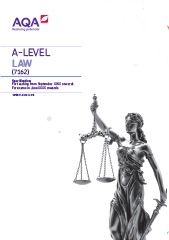Nature of law
|
- Basic understanding of the distinction between enforceable legal rules and principles
and other rules and norms of behaviour.
- Basic understanding of the differences between criminal and civil law and between
different sources of law including custom, statute law and the
common law.
|
Nature of law: law and society
|
- The role law plays in society.
- The effect of law on enforceable rights and the balance required between competing interests (eg public and private).
- The meaning and importance of fault in civil and/or criminal law.
|
Nature of law: law and morality
|
- The distinction between law and morality and the diversity of moral views in a pluralist society.
- The relationship between law and morality and its importance.
- The legal enforcement of moral values.
|
Nature of law: law and justice
|
- The meaning of justice and theories of justice.
- The extent to which the law (civil and/or criminal) achieves justice.
|
The rule of law
|
Basic understanding of the constitutional doctrine of the rule of law and its
application to law making, the legal system and substantive law:
- no person shall be sanctioned except in accordance with the law
- equality before the law
- fairness and clarity.
|
Law making: parliamentary law making
|
Parliamentary law making including:
- Green and White papers
- the formal legislative process
- the influences on parliament
- the doctrine of parliamentary supremacy and limitations on it
- the advantages and disadvantages of influences on parliamentary law making.
|
Law making: delegated legislation
|
- Types of delegated legislation: orders in council, statutory instruments, bylaws (from local authorities and public bodies).
- Parliamentary and judicial controls on delegated legislation.
- The reasons for the use of delegated legislation.
- The advantages and disadvantages of delegated legislation.
|
Law making: statutory interpretation
|
- The rules of statutory interpretation: literal, golden and mischief rules; the purposive approach.
- Internal (intrinsic) and external (extrinsic) aids.
- The impact of European Union law and of the Human Rights Act 1998 on statutory interpretation.
- The advantages and disadvantages of the different approaches to statutory interpretation.
|
Law making: judicial precedent
|
- The doctrine of judicial precedent.
- The hierarchy of the courts including the Supreme Court.
- Stare decisis, ratio decidendi and obiter dicta; law reporting in outline and the reasons for it.
- The operation of judicial precedent: following, overruling and distinguishing.
- The advantages and disadvantages of the doctrine of judicial precedent and the
operation of precedent.
|
Law making: law reform
|
- The work of the Law Commission: reform, codification, consolidation and repeal.
- The advantages and disadvantages of reform through the Law Commission.
|
Law making: the European Union
|
- The institutions of the European Union: the Council, the Commission, the Parliament
and the Court of Justice of the European Union and their
functions.
- The different sources of European Union law: treaties, regulations and directives.
- The impact of European Union law on the law of England and Wales.
|
The legal system: the civil courts and other forms of dispute resolution
|
- Basic understanding of civil courts, including the track system and the appeal
system.
- Other forms of dispute resolution: outline of the tribunal structure and the role of tribunals. The roles of mediation and negotiation.
|
The legal system: the criminal courts and lay people
|
- Basic understanding of the criminal process including the classification of
offences, and the appeal system.
- Criminal court powers and sentencing of adult offenders.
- The role of lay people: the role and powers of magistrates in criminal courts and
the role of juries in criminal courts.
- The advantages and disadvantages of using juries in criminal courts.
|
The legal system: legal personnel and the judiciary
|
- Basic understanding of the different roles of barristers, solicitors and legal
executives.
- Basic understanding of the regulation of legal personnel.
- The judiciary: types of judge.
- The role of judges in civil and criminal courts.
- The independence of the judiciary: security of tenure, immunity from suit, independence from the Executive.
- Reason for and advantages of judicial independence and the methods by which it is
achieved.
|
The legal system: access to justice and funding
|
- Basic understanding of alternative sources of legal advice: help lines, Citizens
Advice Bureau (CAB), law centres and trade unions.
- Private funding: own resources, insurance and conditional fee agreements.
- Basic understanding of public funding: criminal and civil state funding.
|
